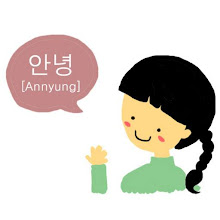
부디 씨가 영화를 봐요.
Bu-di watches a movie.
아버지가 신문을 읽어요.
Dad reads the newspaper.
요코 씨가 음악을 들어요.
Yoko listens to music.
Grammar Focus:
The object particle 을/를 is added to a noun to express that the noun is the object of the sentence. For nouns ending in a vowel, 를 is added, and for nouns ending in a consonant, 을 is added. Common verbs that require this object particle include 먹다 (to eat), 마시다 (to drink), 좋아하다 (to like), 읽다 (to read), 보다 (to see), 만나다 (to meet), 사다 (to buy), 가르치다 (to teach), 배우다 (to learn), and 쓰다 (to write). In colloquial speech, 을/를 is sometimes omitted.

Conversation:
A 무슨 운동을 좋아해요? What kind of exercise do you like?
B 축구를 좋아해요. I like soccer.
A 무엇을 배워요? What do you study?
B 한국어를 배워요. I study Korean.
A 오늘 누구를 만나요? Who will you meet today?
B 여자 친구를 만나요. I’ll meet my girlfriend.
Some notes:
N +하다 -> N하다
When 을/를 is omitted from verbs like 공부를 하다, 수영을 하다, 운동을 하다 and 산책을 하다,the form becomes shortened to a single one-word form: 공부하다, 수영하다, 운동하다 and 산책하다. However, for the verbs 좋아하다 and 싫어하다, because 좋아- and 싫어- are not nouns, the forms 좋아하다 and 싫어하다 are the one-word verb forms.
뭐해요?
The question noun 무엇 can be shortened to 무어 which can be further shortened to 뭐. Thus, the question 뭐를 해요? can be shortened to 뭘 해요? which can be further shortened to 뭐 해요? This form is often used in conversation.
• 무엇-> 무어 -> 뭐
• 무엇을 해요? -> 뭐를 해요? -> 뭘 해요? -> 뭐 해요?
Click below:
N이/가
N은/는
N을/를
N와/과, N(이)랑, N하고
N의
N에 ①
N에 ②
N에서
N에서 N까지, N부터 N까지
N에게/한테
N도
N만
N밖에
N(으)로
N(이)나①
N(이)나 ②
N쯤
N처럼, N같이
N보다
N마다
>> Full of 'Korean grammar in use - Beginner': Click here
search bar
Social Network
Popular post
-
There are Korean Grammar in Use (Beginner) online lessons based on 'Korean Grammar in Use' book. You can keep tracks of your study o...
-
There are Korean Grammar in Use (Intermediate) online lessons based on 'Korean Grammar in Use' book. You can keep tracks of your stu...
-
Due to copyright reasons, starting from 9/11/2023, sayhikorean will only share links to the online book page of the Korean Language Institut...
-
According to the KIIP book of Korea Immigration & Integration Program - Level 3 (이민자를 위한한국문화 한국어와 - 중급1), Say Hi Korean translated all ...
-
KIIP Level 4 (New edition) According to the official KIIP book “한국어와 한국문화 – 중급2” (Korean Language and Culture for Immigrants – Level 4...
-
Due to copyright reasons, starting from 9/11/2023, sayhikorean will only share links to the online book page of the Korean Language Institut...
-
There are Korean Grammar in Use (advanced) online lessons based on 'Korean Grammar in Use' book. You can keep tracks of your study o...
-
There are sample tests and practice tests of KIIP from level 0 to level 5 for free download. 1/ KIIP level 0 sample test: https://goo.gl...
-
Vitamin Korean is available in various online bookstores with 10% discounts such as Coupang. You can buy it from the link below. Buy the w...
-
If you think the books are interesting and useful, I suggest buying them to support the authors and you can buy via Coupang at the link at t...
Label
- Advanced Korean Grammar 84
- Basic Korean Grammar 114
- Ebook 15
- Festivals in Korea 1
- Guardians of Heritage 5
- History of Korean 16
- Intermediate Korean grammar 94
- K-pop 4
- KIIP Guideline 8
- KIIP level 2 22
- KIIP level 3 36
- KIIP level 4 38
- KIIP level 5 32
- Korea technology 3
- Korea Tourism 53
- Korean Culture 80
- Korean Economy 4
- Korean Expression 6
- Korean Film 7
- Korean Foods 21
- Korean grammar dictionary 612
- Korean Job 4
- Korean Lifestyle 5
- Korean News 267
- Korean reading practice 451
- Korean Sports 4
- Korean vocabulary 6
- Let's learn Korean culture 37
- National Museum 3
- News in Korean 78
- Study in Korea 2
- TOPIK II 쓰기 18



.jpg)





0 comments: